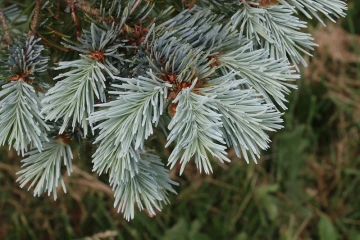
The Tree Library Flickr.com
Botanical Family: Pinaceae
Scientific Name: Pseudotsuga menziesii var. glauca
Common Names: Rocky Mountain Douglas fir, Inland Douglas fir, blue Douglas fir
Botanical Description:
Pseudotsuga menziesii var. glauca is a large, fast-growing, evergreen conifer, of variable conical or pyramidal form, achieving heights of up to 40 meters (1,2,3,5). Var. glauca is somewhat smaller and slower growing than its coastal counterpart, var. menziesii (2,7). The bark is brown to gray, deeply furrowed, with the internal cork being a red-flecked, cream color (3). The branches are long and whorled, with lower branches drooping downwards, and the upper branches ascending (1,3,5). Young branches are slender, and pubescent, becoming glabrous with age (3). The 15-30 mm long, flattened needles are solitary, short-stalked, radially arranged, and dark green to blue-green in color, with the upper side being darker in color and the lower side pale (2,3,5,7). Pseudotsuga menziesii var. glauca is monoecious, and wind-pollinated, with 15-20 mm long, yellow-red, pollen-bearing cones and 4-7 cm long, reddish-brown, seed-bearing cones with thin scales, and characteristic bracts that are long, three-tongued, spreading, and reflexed (2,3,6). Cones are pendulous (they hang down), and appear from March to May, with the seeds ripening from September to November (1,3,5). The seeds are 5-6 mm long and have a wing that extends further than the main body of the seed (3).
Ecological Significance:
Pseudotsuga menziesii var. glauca occurs inland at elevations of 5,000 – 10,000 ft and is adapted to colder and drier environments than the coastal variety (2,3,4,8). Its geographic range extends east from the Cascade and Sierra Nevada Mountain ranges, from central British Columbia south to central Mexico (4,8). The larger, coastal, Pseudotsuga menziesii var. menziesii, in contrast, occurs along the west coast, from British Columbia south to the Santa Cruz mountains in central California (4). In Arizona, Inland Douglas fir is often found in association with white fir (Abies concolor) and Arizona pine (Pinus arizonica), covering large areas in the Huachuca, Rincon, Santa Rita, Santa Catalina, Chiricahua, Graham, Santa Teresa, Winchester, and Galiruo mountains (8). Oaks (Quercus spp.), maples (Acer spp.), and quaking aspen (Populus treuloides), are commonly found growing in the cool understory of these large conifers (8). Douglas fir provides habitat and cover for many animals, including deer, elk, bighorn sheep, mule deer, white-tailed deer, and other small mammals (8). Birds of prey, such as Mexican spotted owls, Cooper’s hawks, sharp-shinned hawks, and great-horned owls may use Douglas fir-conifer stands for breeding and nesting sites (8).
Ethnobotanical Value:
Pseudotsuga menziesii is one of the most important timber trees worldwide, and of especially high economic value in the United States and in Europe (6). In Europe, it is the most abundantly cultivated non-native tree (6). It is also popularly used as a Christmas tree in the United States (6). Native Americans have used various parts of Douglas fir trees for tools, medicine, and ceremonies (3,10). Many coastal tribes in the Pacific Northwest valued the wood of Douglas fir trees as a fuel source (9). The wood was also used to create various tools, spear handles, dip-net poles, and harpoons (9). The pitch was utilized for a variety of purposes including as a medicinal salve for cuts (Shasta), as chewing gum (White Mountain Apache), as a sealant to produce water-tight vessels (White Mountain Apache), and in torches (3,9). The needles and young sprouts were used as a spice for meat and Isleta Puebloans made into a tea used to treat joint pain (3,9,10). Yuki people created decoctions from young buds to treat venereal disease (10). A tea made from the bark was used by the Sinkyone to ease colds and stomach ailments (10). Although it is not clear which parts of the tree were used, Kayenta Navajo of Arizona used the tree to treat headaches, stomach problems, and they also ground parts of the tree with corn seeds to prepare a blessing for good crops (10).
Distribution:
Arizona, Colorado, New Mexico, Nevada, Utah, Idaho, Montana, Wyoming, Oregon, Texas, Washington, Mexico and British Columbia

